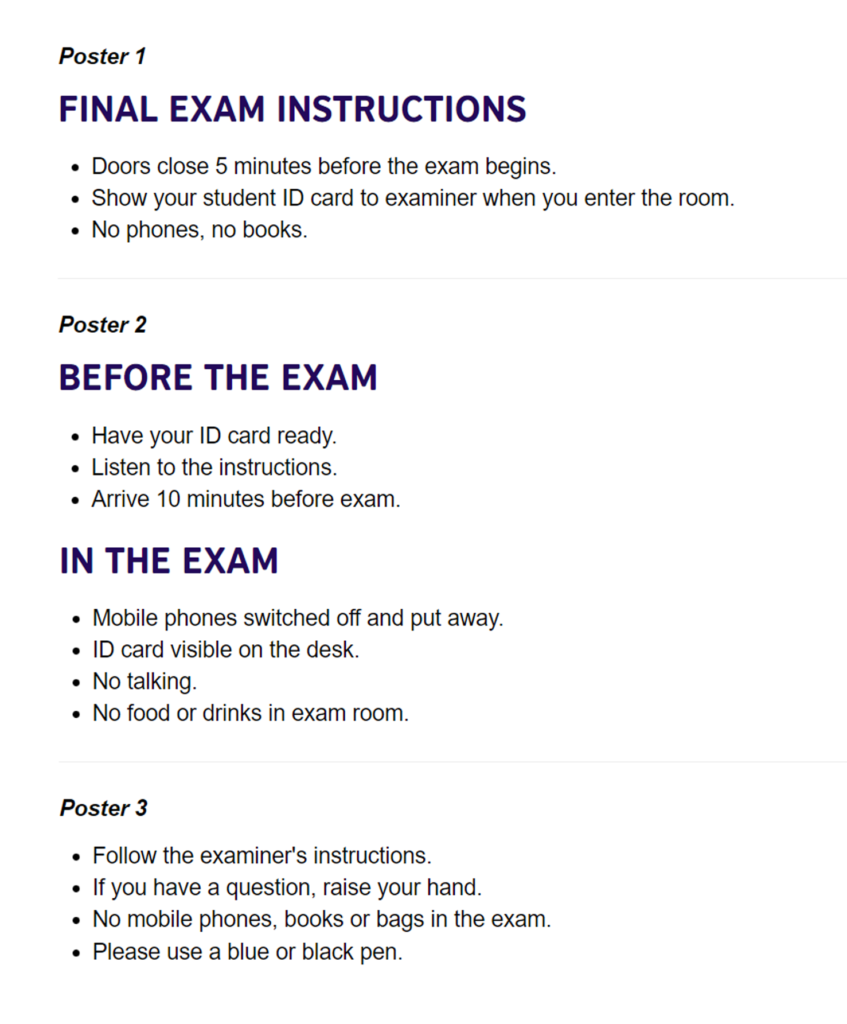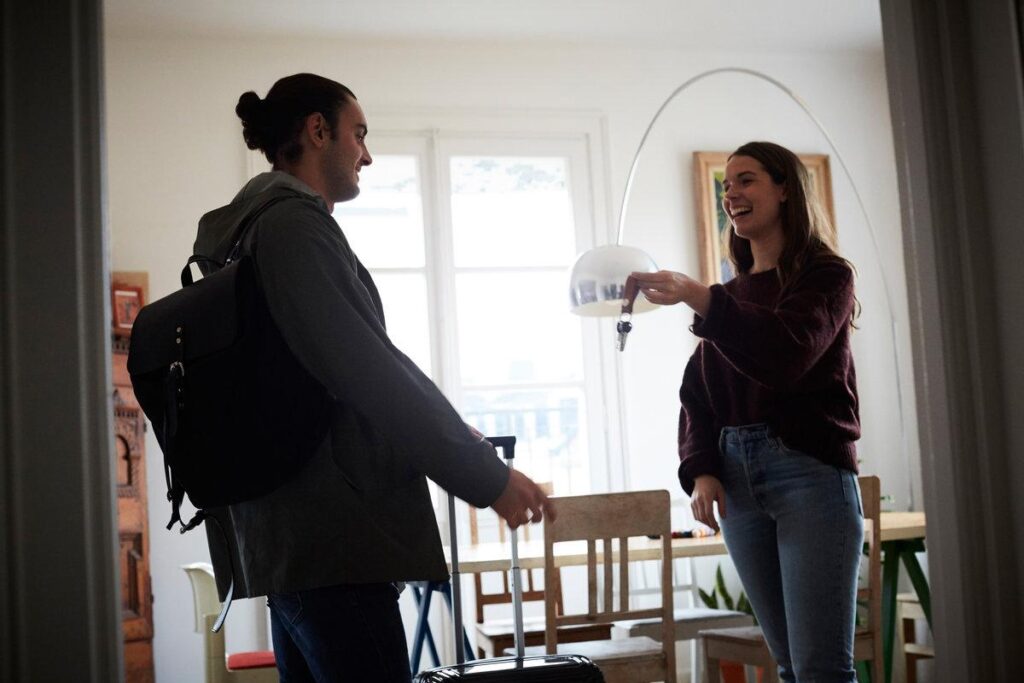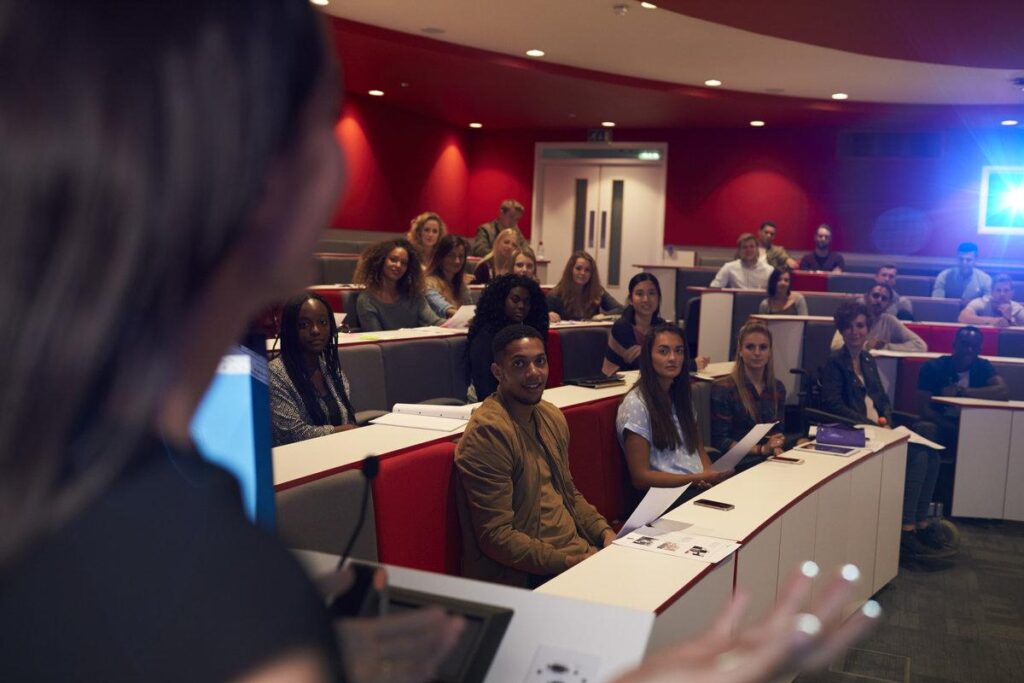Lección 2
Colors /Colours
Black negro |
Blue azul |
Brown café |
Gray gris |
Green verde |
Ligh blue azul claro (cielo) |
Orange naranja |
pink rosa |
Purple morado |
Red rojo |
White blanco |
Yellow amarillo |
Vocabulary
Yes si | |
Boy muchacho / niño | |
Girl muchacha /niña | |
Man hombre / señor | |
Woman mujer / señora / señorita | |
House casa | |
Car carro / coche | |
Big grande | |
Little pequeño / chico | |
Small pequeño / chico |
Old viejo | |
Young joven | |
New nuevo | |
American americano | |
Mexican mexicano | |
Where dónde | |
Apple manzana | |
Sweet dulce (adj) | |
Desk escritorio |
Modismos
Hello hola |
Good bye adios |
Good morning buenos días |
Good afternoon buenas tardes |
Good evening buenas noches (para saludar) |
Good night buenas noches (para despedirse) |
The young man (boy) el Joven |
The young woman (girl) la Joven |
The old man el anciano |
The old woman la anciana |
A poster for exam candidates

Read the poster outside an exam room to practise and improve your reading skills.
Do the preparation task first. Then read the text and do the exercises.
Preparation
Reading A1: A poster for exam candidates – preparation
Match the words with the pictures.
Reading text

Task 1
Reading A1: A poster for exam candidates – 1
Choose all the posters that say something about …
Task 2
Reading A1: A poster for exam candidates – 2
Choose the sentence that has the same meaning.
A poster at work

Read an invitation to an office event to practise and improve your reading skills.
Do the preparation task first. Then read the text and do the exercises.
Preparation
See MoreReading A1: A poster at work – preparation
Match the times to the phrases.
Reading text
See More

Task 1
See More
Reading A1: A poster at work – 1
Put the answers to the questions in the gaps.
Task 2
See MoreReading A1: A poster at work – 2
Decide if the statements are true or false.
The history of hand gestures

Listen to a lecture about the history of hand gestures to practise and improve your listening skills.
Do the preparation task first. Then listen to the audio and do the exercises.
Preparation
See MoreListening C1: The history of hand gestures – preparation
Match the words that go together.
Transcript
See MoreEarlier on in today’s lecture, I mentioned the importance of hand gestures and said that I’d touch on some of these, pardon the pun! Hand gestures are, of course, often culturally bound and can vary from group to group. But there are a few of them which, if not universal, are very common indeed around the world. I’d like to focus on the history of four gestures in particular: the salute, the thumbs up, the high five and the handshake.
The salute, a gesture most associated with the military, may have originated in the 18th century. The Grenadier Guards, one of the oldest regiments of the British Army, used helmets in the form of cones. These were held in place by chinstraps. It was difficult to raise your helmet when greeting someone, so the soldiers simply touched their head with one short movement of the hand before quickly putting it back down again at their side.
The thumbs-up gesture apparently goes back a lot further. It’s widely believed that this gesture goes back to Roman times when gladiators fought in front of the emperor and eager crowds in the Colosseum. The fallen gladiator’s fate was decided by the audience. If they felt he had fought well, they showed their approval with a thumbs-up gesture. The emperor would then confirm this and thereby would spare the gladiator’s life. If the crowd gave a thumbs down, on the other hand, that meant execution.
However, there are no reliable historical references to thumbs going either up or down in the Colosseum. It may be that if the crowd wanted to spare the gladiator’s life, then they would actually cover up their thumb and keep it hidden. They would only extend their hand and thumb if they wanted the gladiator killed. This actually makes more sense, as the emperor could much more easily see what the crowd was indicating when looking out over a huge arena.
The high-five hand gesture is almost universally used as a greeting or celebration. Many see its origins in baseball. Two US teams lay claim to inventing the high five: the Los Angeles Dodgers in 1977 or the Louisville Cardinals in 1978. It’s quite likely that it was neither, and the gesture might have a much earlier origin again. It is very similar to a 1920s Jazz Age gesture known as the ‘low five’, or ‘giving skin’. This gesture involved people slapping each other’s lower hands, also in celebration. There are, in fact, numerous references to the low five in films of the era. Perhaps the high five is just an evolution of that gesture.
The final gesture I’m going to mention today is the handshake. It dates back as a greeting at least as far as Ancient Greece. In the Acropolis Museum in Athens, the base of one of the columns shows goddess Hera shaking hands with Athena, the goddess of wisdom and courage. It’s thought that shaking hands, rather than bowing or curtseying, showed both parties as equals. In 17th-century marriage portraits in Europe we find many examples of handshakes between husband and wife. Now, of course, the handshake has a multitude of uses: meeting, greeting, parting, offering congratulations, expressing gratitude or completing an agreement. In sports or other competitive activities, it is also done as a sign of good sportsmanship. In this way, the gesture has not strayed from its original meaning to convey trust, respect and equality.
Task 1
See MoreListening C1: The history of hand gestures – 1
Complete the sentences with one, two or three words.
Task 2
See MoreListening C1: The history of hand gestures – 2
Complete the sentences with the words.
The helix

Listen to a lecture about the helix shape to practise and improve your listening skills.
Do the preparation task first. Then listen to the audio and do the exercises.
Preparation
See MoreListening C1: The helix – preparation
Match the words with the definitions.
Transcript
See MoreI’d like to turn now to the object which is the main point of this talk: the helix. This is a fascinating mathematical object which touches many parts of our lives. Movement, the natural world, the manufactured world and our genetic make-up are all connected to the shape of the helix.
A helix is a type of three-dimensional curve that goes around a central cylindrical shape in the form of a spiral, like a corkscrew or a spiral staircase. The helix is a very popular shape in nature because it is very compact. In fact, helices are sometimes referred to as ‘nature’s space saver’. In architecture too, the helix shape of a spiral staircase is an attractive option in buildings where space is very restricted.
The most renowned type of helix is probably the double helix of DNA, or deoxyribonucleic acid. DNA is made of two helices that curve around each other, a bit like a twisted ladder. DNA contains the genetic information or ‘code’ that determines the development and functioning of all known living things. The helix shape is a very efficient way to store a long molecule like DNA in the limited space of a cell.
There are different types of helices. Helices can twist clockwise, right-handed, or anti-clockwise, left-handed. An interesting experiment is to hold a clockwise helix, such as a corkscrew, up to a mirror. The clockwise helix appears to become counterclockwise.
We can perceive examples of helices in many areas of our world. Spiral staircases, cables, screws and ropes can be right-handed or left-handed helices. A helix that goes around a cone is called a conical helix. Examples of conical helices are screws or the famous spiral ramp designed by the architect Frank Lloyd Wright in the Guggenheim Museum in New York.
Helices are also prevalent in the natural world. The horns of certain animals, viruses, seashells and the structure of plants, flowers and leaves can all contain helices. The human umbilical cord is in fact a triple helix.
With the discovery that the helix is the shape of the DNA molecule, it is not surprising that the helix is found in so many areas. It’s one of the most natural shapes in nature.
Let’s turn our attention now to the mathematical description of the helix. You’ll need a pen and paper for the next part of the talk as I am going to give you some variables to write down. Take your time to notice the different …
Task 1
See MoreTask 2
See MoreListening C1: The helix – 2
Write the adjective form of the word in brackets in the gap.
Tech addiction

Listen to the radio programme about tech addiction to practise and improve your listening skills.
Do the preparation task first. Then listen to the audio and do the exercises.
Preparation
See MoreListening C1: Tech addiction – preparation
Match the words with the definitions.
Transcript
See MorePresenter: The sound of kids hanging out together. Or, at least, how it sounded a few years ago. Nowadays a group of, well, just about anyone – kids, teens, tweens, their parents – might sound a lot more like this …
Most of us spend hours a day with our heads bent over our smartphones. Research suggests teenagers spend as many as nine hours a day, while pre-teens spend up to six.
Teen voice: I don’t know, it’s, like, the first thing I do in the morning, check in and see who’s posted anything overnight. It’s my alarm clock so I kind of have to look at it and then, you know, it’s pretty hard not to scroll through.
Presenter: And it’s not just teenagers and millennials, Generation X and even the Baby Boomers are almost as bad.
Adult voice: I’m online most of the day for work and you’d think I’d be sick of screens by the time I get home, but most of my news comes through Facebook and I’m really into food so I’ll hold my hands up to being one of those people who posts photos of their meals.
Presenter: But are we addicted to our phones and apps? And does it matter? Former Google and Facebook employees certainly think so. So they’ve set up a non-profit organisation, the Center for Humane Technology, to reverse the digital attention crisis and promote safe technology for children.
Expert: Anyone who’s seen queues round the block for the latest iPhone has to wonder what these people are thinking. You’ve literally got people sleeping in the street to get the newest device, probably not even talking to anyone else in the queue because they’re on social media, taking selfies in the queue to post to Instagram. If that’s not addiction, it’s certainly obsession.
Presenter: A more formal definition of addiction describes it as a repeated involvement with an activity, despite the harm it causes. Someone with an addiction has cravings – that feeling that you haven’t checked your phone for two minutes and can’t relax until you get your hands on it again. They may have a lack of self-control and not realise their behaviour is causing problems – like texting while cycling or falling off a cliff taking a selfie. And, in case you’re wondering, I read about both of those via the news app on my phone, which updates every couple of minutes with the latest stories … definitely addicted. So the ‘Truth about Tech’ campaign by Common Sense Media and the Center for Humane Technology couldn’t come fast enough for most of us. But it’s children who are probably most at risk because of the effect tech addiction might be having on their brain development. Professor Mary Michaels of the Atlanta Future Tech Institute has been working with very young children. Mary, thanks for dropping by. What is your research telling us?
Mary: Well, we know that screen time is affecting key aspects of healthy child development, like sleep, healthy eating and what psychologists call ‘serve and return’ moments, which are when parents respond to babies seeking assurance and connection by making eye contact, smiling or talking. All perfectly normal things we do and which help lay the foundations of babies’ brains. It’s much harder to engage with a baby normally if you’re looking at your phone. Or, even worse, if parents give a crying child a phone to distract them instead of talking to them or hugging them, and that might lead to them failing to develop their ability to regulate their own emotions.
Presenter: And what about older children?
Mary: Again, we know that teenagers who spend a lot of time on social media are 56 per cent more likely to report being unhappy and 27 per cent more likely to suffer depression. Teenagers are especially vulnerable because they’re more sensitive to highs and lows anyway, so we’re looking at, potentially, higher instances of suicide, schizophrenia, anxiety and addiction in teens which is exacerbated by dependence on technology.
Presenter: It sounds like a vicious circle. They’re more likely to get addicted to smartphones and social media and that addiction itself makes them candidates for other addictions.
Mary: Yes, that’s right.
Presenter: Time to stage an intervention! Is there anything we can do to make tech less addictive?
Mary: Setting devices to greyscale, which is basically black and white, might make them less appealing. Scrolling through a newsfeed of boring, washed-out photos just doesn’t create the same rush as bright colours perhaps. And you can turn off the notifications that are constantly pulling you back in to check your phone.
Presenter: So is it …
Task 1
See MoreTask 2
See MoreListening C1: Tech addiction – 2
Match the expressions with their meanings.
Renting a house

Listen to four different people talking about their experiences with renting accommodation to practise and improve your listening skills.
Do the preparation task first. Then listen to the audio and do the exercises.
Preparation
See MoreListening C1: Renting a house – preparation
Match the words with the definitions.
Transcript
See MoreA
We saw the ad in the summer, in about July, I think, but we weren’t really serious about moving then so we didn’t even go and see it. It wasn’t until November when they readvertised it that we got in touch with the agency and had a look. They’d put the price down since the summer too, I suppose because it had been empty so long, so that made it more affordable for us which helped us make up our minds. It was perfect – a bigger garden for the kids and enough space for an office. In winter it was lovely, very cosy, in fact, which is important to me as I really feel the cold, whereas my husband will open a window when it’s minus temperatures outside! Anyway, in July when summer really started and we had that heatwave, we understood why no one had wanted to rent it over summer. It was boiling! All those lovely big windows that made the flat so light and open were like a greenhouse as soon as it got warmer. From about 8 in the morning until 7 in the evening, it was like living in a sauna! We couldn’t stand being at home, and weekends were especially bad. No air conditioning, of course. If only we’d gone to see it when it was first advertised in July, we’d never have moved in!
B
I always rent apartments when I go on holiday, rather than staying in hotels. Hotels are so impersonal, aren’t they? This way you get to feel like you really live in the place you’re visiting. It’s the first time I’ve done it the other way round, though, and rented out my place … but it seemed like a good way of making some extra money. The website is really easy to use and they only charge five per cent commission, which is lower than a lot of the other holiday rental sites. It’s all about the photos and the reviews. Get the photos right and the place can look really upmarket and spacious, but you don’t want to make it look too much better than it really is or you end up with a bad review. It’s better to undersell and overdeliver so guests are pleasantly surprised and leave an extra positive review. So far, I’m averaging three stars because of one bad review that brought my average down from four and a half stars, but hopefully I’ll get it back up during the busy season.
C
Buying a house seems so far out of my reach it’s almost impossible, as it is for loads of people my age these days. My parents always told me renting was throwing money away, but it was different in their day. Then people could afford to buy a house on a normal salary, but nowadays house prices are so high and no bank will look at you unless you’ve got a huge deposit. The problem with my dream of buying is that it’s never going to come true. Not unless my parents help me out, but I’ve got two sisters and we’re all in the same position. At least they’ve both got good jobs. Not good enough to buy a house, but at least they can afford to rent places of their own in nice areas. I just don’t earn enough to rent around here. Even if I get promoted to manager, it’ll be tough to find somewhere unless I share, and call me fussy, but there aren’t that many people I want to share a bathroom and kitchen with. Some days I think I’ll be stuck living with my parents forever – even renting is like a dream to me.
D
At first our landlord was really helpful, couldn’t do enough for us. You hear stories of nightmare landlords and we felt like we were really lucky, or so we thought anyway. He redecorated the whole place, from top to bottom, and let us keep all the bills in his name so we didn’t have the bother of contacting all the companies ourselves. He even offered to come round and do the gardening as he knew we both worked long hours and might not have time. That’s where the problems started now I look back. Then he’d pop round ‘just to check everything’s OK for you’ … once a month, then twice a month. Soon he was coming every week with some excuse or other. In the beginning we’d invite him in for tea, but it was only encouraging him, so when we realised, we’d try to have the conversation on the doorstep instead. It got so bad we pretended to be on our way out if we saw him coming up the path. We’d grab our coats and walk round the block until he’d gone. I don’t know if he was just lonely or just didn’t trust us not to ruin his precious house. In the end we gave our notice and found somewhere else. It’s a shame because we really loved that house, but at least it’s more peaceful in the new place.
Task 1
See MoreTask 2
See MoreListening C1: Renting a house – 2
Write the correct form of the word in CAPITALS to complete the sentences.
Introverts – redressing the balance

Listen to a talk about social psychology to practise and improve your listening skills.
Do the preparation task first. Then listen to the audio and do the exercises.
Preparation
See MoreListening C1: Introverts – redressing the balance
Match the words with the definitions.
Transcript
See MoreIf I asked you to describe a great leader, I’d be willing to bet certain traits come to mind … someone charismatic, dynamic, inspiring, a confident public speaker. You’re probably imagining a man too, but that’s a bias we’ll save for another talk! We tend to think of great leaders as people who naturally take to the stage, who draw other people to them by their sheer presence, who are extroverts. But history has also been transformed by people who don’t fit these descriptions. People like Rosa Parks, Eleanor Roosevelt and Gandhi. These people would have described themselves as shy, quietly spoken … as introverts.
Of course we’re drawn to extroverts. They’re usually charming and persuasive, fun to be around. They’re not quietly in the corner somewhere reading a book where we might not notice them. Introverts are mostly happy to let the extroverts take the attention; they’d rather not be in the spotlight, they’d rather finish that book. If they become leaders, it’s not because they want to be the centre of attention, it’s because they feel compelled to act. They lead not because they enjoy giving orders but because circumstances have put them in a position to make change. If they’re the boss, they allow space for the ideas of others to grow because they’re not trying to make their mark. An introvert sounds like a pretty good boss, right? You won’t need to worry about them stealing your ideas or talking over you in a meeting.
Some of our great creators are introverts too. People like the writer JK Rowling, the great thinker Darwin and the designer of the first Apple computer, Steve Wozniak. It turns out coming up with good ideas is easier when you’re engaged in quiet, solo contemplation than when you’re leading the cheerleading squad. Not that I’m saying there’s anything wrong with cheerleaders! Extroverts are great – some of my favourite people are extroverts. But why is the world so set up for extroverts and so hard for introverts? Why are we always encouraging our kids to speak up, join in, work as a team?
Nowadays, most schools and most workplaces are set up with the extrovert in mind. Children no longer sit in rows in desks, they sit in groups of four or six, doing group projects. Even subjects like maths and creative writing are taught with an emphasis on group collaboration, even though most writers sit alone in front of their computer or typewriter, with nothing between them and the blank page. A kid who prefers to go off into a corner and work alone starts to look like a problem. What’s wrong with Janie? Why isn’t she joining in? Studies show teachers think extroverts make better students, even though introverts actually tend to get higher grades. We’re telling our introverted kids something is wrong with them, that they need to be more sociable, more outgoing. We’re giving them fewer opportunities for the quiet contemplation they need in order to produce the best work and be their best selves.
And then at work we do the same. Most offices today are open plan, everyone working and creating noise in one big room, attending team-building workshops or group brainstorming sessions; the introverts’ worst nightmares. The introverts at school are judged negatively by their teachers and when they reach the workplace, they’re passed over for promotion into leadership positions. But introverts typically take fewer risks and make more careful decisions, and don’t we need those traits too?
I’m not saying let’s get rid of extroverts and grab all those talkative, sociable performers at primary school and send them off to the library for four hours a day of solitude until they learn to tone it down. I’m not saying that at all. I’m saying we’re doing something like the opposite of that to introverts and we need to stop. We need to allow them space to be themselves and then we’ll end up getting the most out of our extroverts and our introverts. Let’s teach all our kids how to work with others and how to work on their own. Let’s create space in offices and at conferences for people to work on their own when they want to and give them the opportunity to come together to share ideas. Let’s give staff ‘away days’, where they go off into the woods, walk up a mountain or wherever, to work on something alone, as well as the ‘team-building day’ where everyone learns to dance salsa together.
The future is complicated, with a lot of huge, complex problems to solve. Let’s make sure we’ve got our best people working on those problems in the way that suits them best. And then we’ve got to make sure we listen to our extroverts and our introverts and everyone who sits somewhere in between on the scale. We’re going to need all of them.
Task 1
See MoreTask 2
See MoreInnovation in business

Listen to the business podcast about innovation to practise and improve your listening skills.
Do the preparation task first. Then listen to the audio and do the exercises.
Preparation
See MoreListening C1: Innovation in business – preparation
Match the words with the definitions.
Transcript
See MoreWelcome to today’s Business4U podcast. The focus of this podcast is to think about innovation and why it’s important, and also to look at different types and stages of innovation. By the end of it, you will hopefully have a better grasp of the topic of innovation and be able to better understand and drive innovation in both your working and personal lives.
So, why is innovation important? Well, simply put, without innovation it would be difficult to make progress. Organisations and societies would stagnate. Innovation is what drives us forward. It’s what forces us to compete in the business world. It’s what leads to better products and services, and solutions to new and existing problems. From a business point of view, it’s also something which is necessary for survival.
Four key types of innovation are incremental, disruptive, architectural and radical.
Incremental innovation involves innovating in increments, or small stages. Step by step. It focuses on existing markets and technologies and aims to make improvements and design changes to existing products and services.
Disruptive innovation aims to bring new ideas, like technology or processes, to existing markets. In that sense, the innovations will disrupt the market and the companies currently serving that market. The first touchscreen smartphones disrupted the mobile phone industry because up to then, mobile phones had buttons and keypads.
Architectural innovation involves taking successful ideas from one market or industry and applying them to a new or different market. This often happens when people think of other unconventional uses of existing technology. A good example of this can be seen in vacuum company Dyson’s entry into the hand dryer and hairdryer market. Their advanced airflow technology from their vacuum cleaners was applied in reverse to machines that blow out air. In the case of these examples, it’s personal hairdryers and hand dryers in public toilets.
And finally, we come to radical innovation. This is where a completely new idea is created for a market that doesn’t exist yet. It’s often what we think of when we think of innovation and it often swallows up existing markets. For example, the birth and growth of digital and downloadable music has practically led to the death of music CDs, and even DVDs. Similarly, film and TV streaming services may lead to the demise of traditional TV within a few short years.
Moving on from types of innovation, let’s have a quick look at five key stages of innovation.
The first stage is Idea generation. This is where you think of the initial idea and develop it into a more detailed proposal or plan.
The next stage is Support. You need to check if you can get support for it, for example from senior leaders or stakeholders in your company. If you’re innovating in your personal life, then the support you might need could be from friends or family. Do they think it’s a good idea and do they think it would work?
The third step is to Experiment and test out the idea. This could mean creating a sample or a prototype of it, if it’s a product. Or if it’s a service, you could test out a basic version of it.
The fourth step is Evaluation. You need to assess how successful your experiments were and what chances of larger success your idea will have.
And finally, you then need to actually Implement your idea. That’s the fifth stage.
So, there you have it. We’ve looked at four key types of innovation: incremental, disruptive, architectural and radical, and also five stages of successful innovation: firstly, idea generation. Then, get support. Next, experiment and test out the idea. The fourth stage is evaluation and finally implementation.
Task 1
See MoreListening C1: Innovation in business – 1
Are the sentences true or false?
Task 2
See MoreListening C1: Innovation in business – 2
Put the stages of innovation in the correct order.
Office party planning

Listen to the conversation with an event planner to practise and improve your listening skills.
Do the preparation task first. Then listen to the audio and do the exercises.
Preparation
See MoreListening B2: Office party planning – preparation
Match the words with the definitions.
Transcript
See MoreAyako: Hello, sales department. This is Ayako speaking. How can I help you?
Sam: Hi, Ayako, this is Sam from Events-4-U. I’m calling about the piano you want at your Christmas party next month.
Ayako: Oh, good. It would be a great surprise to have one there for our boss for the night. He can play and it would be a great addition for the party. Have you been able to source one?
Sam: Well, yes, I have, but …
Ayako: But what?
Sam: Well, we’re going to either have an issue with the logistics or the budget, or possibly both.
Ayako: Oh dear.
Sam: Well, we’ve found a baby grand piano, as you requested, and it’s available for the date you want.
Ayako: OK, great. So what’s the issue? Is it too expensive?
Sam: No, it’s within the budget you gave me, so everything there is OK. But it’s too wide for the entrance doorway into the building.
Ayako: Oh, I see. So what are our options? Could we dismantle it outside and reassemble it inside?
Sam: Er, no. Unfortunately, you can’t really do that with pianos. But don’t worry, I’m sure we can find some inventive solution.
Ayako: Do you have any ideas?
Sam: Well, we could hoist it up to the first-floor balcony. The door there would be large enough to fit it through.
Ayako: Great. That sounds like a good plan.
Sam: That would work, though it would increase the cost considerably as we’d need a crane, an extension on the insurance policy and probably two to three additional people to manage getting it successfully into the building.
Ayako: Oh, I see. Well, we can definitely stretch the budget by about ten per cent, but we shouldn’t go over that. If we exceed the budget by more than ten per cent, then other areas of the party budget will have to be cut. And we don’t really want that.
Sam: OK, so this idea won’t work then. Sorry if I wasn’t being clear. The considerable budget increase I was referring to would add a further fifty per cent. You know, cranes are expensive.
Ayako: Oh … um … OK. So what other options do we have?
Sam: Well, how fixed are you on the piano being a baby grand? Would an upright piano be an option?
Ayako: Hmm. I don’t know.
Sam: It would fit through the door on the ground floor and cause fewer problems. I’ve also got the option on a really nice white vintage upright piano, with black design work.
Ayako: OK. That sounds like it might work. Could you send me over some photos of it?
Sam: I’ll do it now, together with the rental and delivery information and costs.
Ayako: Great. Thanks, Sam. Let me think about it and I’ll call you back later today.
Sam: Sure, no problem. I’ll wait for your call.
Task 1
See MoreListening B2: Office party planning – 1
Are the sentences true or false?
Comentarios recientes